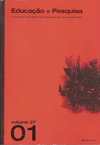La lectura como práctica cultural: conceptos para el estudio de los libros escolares
DOI:
https://doi.org/10.1590/S1517-97022001000100002Palabras clave:
Prácticas de lectura, Cultura escolar, Libros escolaresResumen
Este artículo presenta una perspectiva para el estudio de prácticas de lectura en aula basada en el trabajo del historiador francés Roger Chartier. Para este autor, "los actos de lectura que dan a los textos sus significados plurales y móviles se sitúan en el encuentro entre las maneras de leer y los protocolos de lectura dispuestos en el objeto leído" (Chartier, 1993). Su análisis se centra en aspectos materiales del libro y prácticas de lectura, además del texto en sí. Se ilustra este abordaje con el análisis de una clase en una escuela rural mexicana. En este caso, la maestra presentaba un cuento tomado del libro de texto, siguiendo de cerca el protocolo implícito de la lección. Sin embargo, tanto el formato del texto como las maneras de leer influyeron en su interacción con el grupo. El artículo discute las relaciones cambiantes que los niños construyen con el mundo de la escritura a partir de su experiencia escolar. La historia de la lectura muestra una inflexión significativa entre la lectura intensiva del texto único y la aparición de patrones de lectura extensiva de múltiples textos, entre ellos, los libros escolares. Sin embargo, Chartier argumenta que el proceso de apropiación siempre transforma las prácticas culturales y los significados, según cada contexto. Una mayor atención a las maneras de leer en las aulas puede revelar múltiples apropiaciones de los libros de texto que señalan diversos tipos de relación, algunas más incluyentes que otras.Descargas
Los datos de descarga aún no están disponibles.
Descargas
Publicado
2001-06-01
Número
Sección
Artículos
Licencia
Los conceptos emitidos en los artículos son de exclusiva responsabilidad de sus autores y no reflejan necesariamente la opinión de la redacción.
Está permitida la reproducción total o parcial de los trabajos, siempre y cuando se indique explícitamente la fuente.
Cómo citar
La lectura como práctica cultural: conceptos para el estudio de los libros escolares . (2001). Educação E Pesquisa, 27(1), 11-26. https://doi.org/10.1590/S1517-97022001000100002



